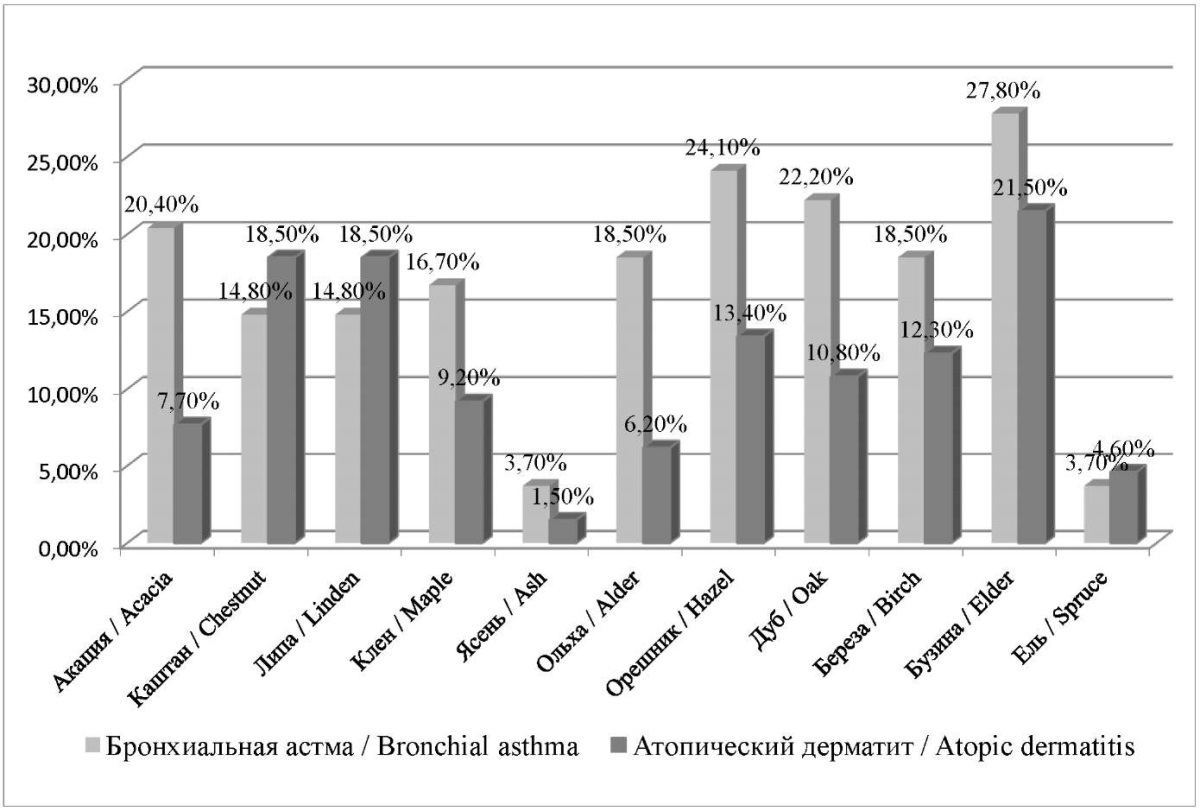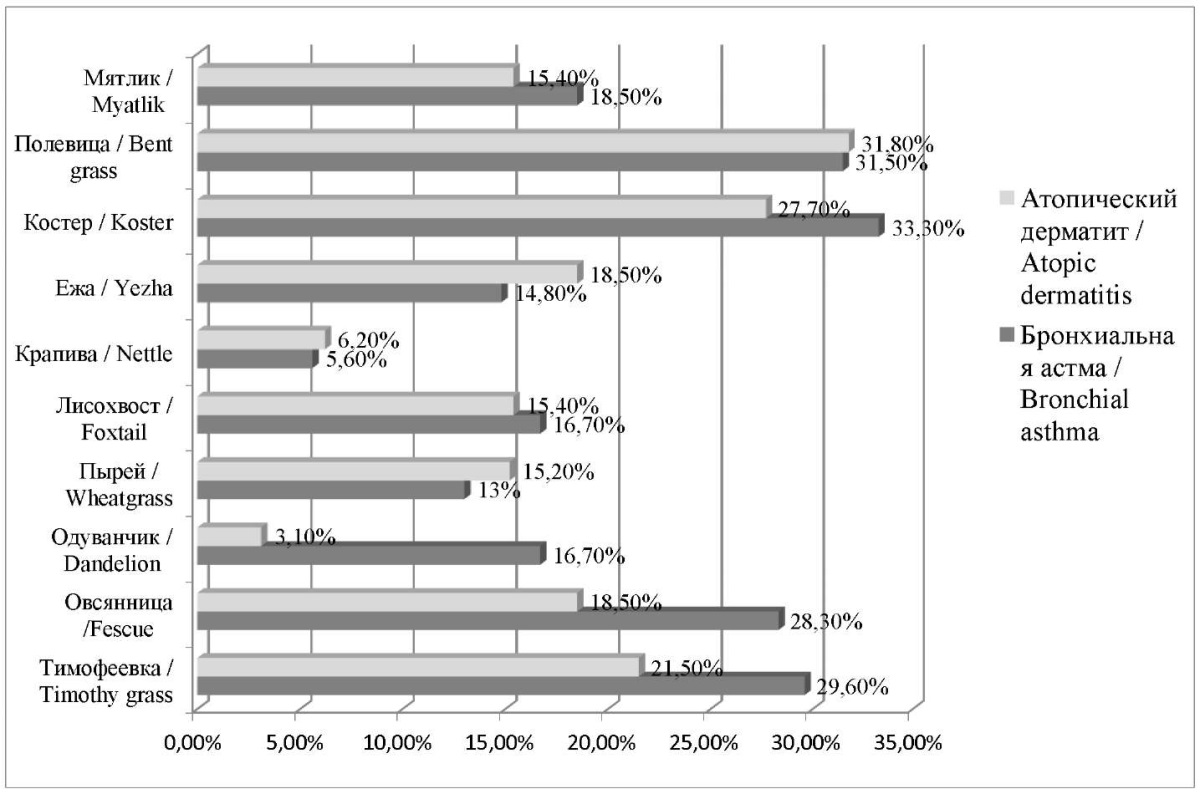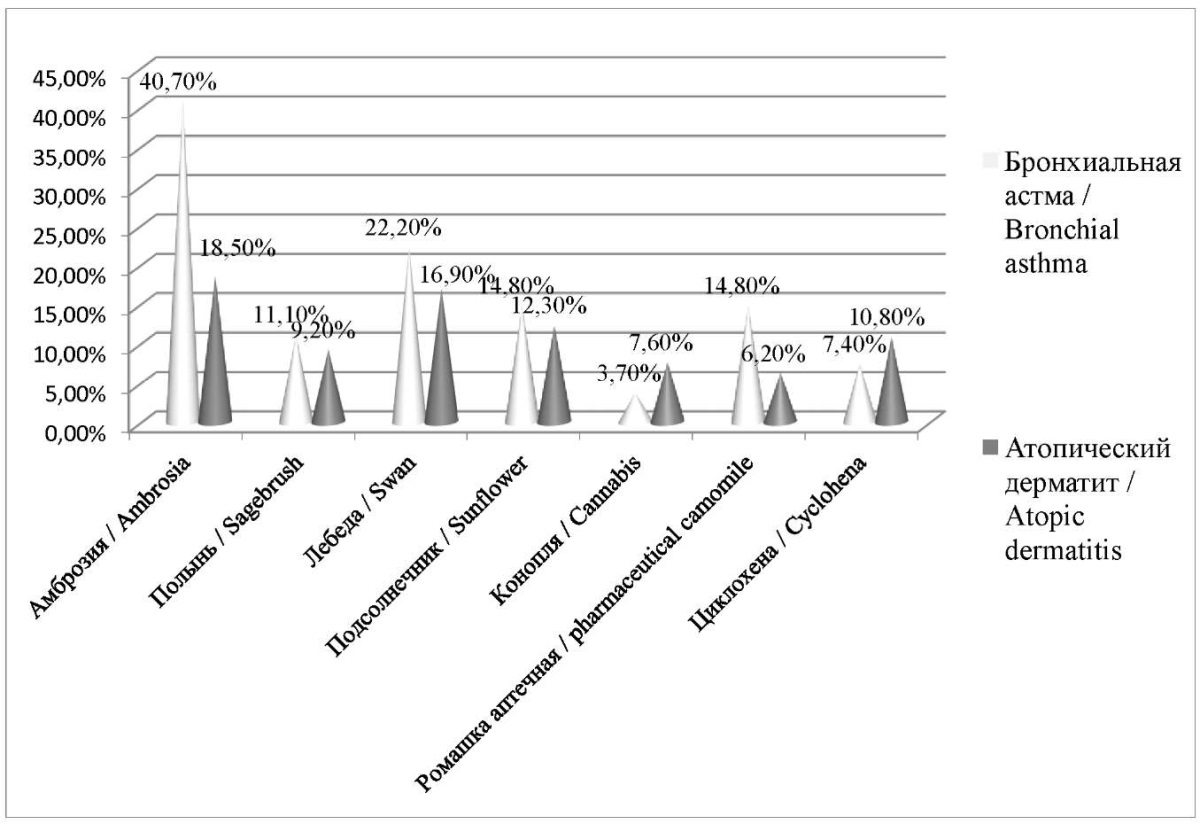Scroll to:
The spectrum of pollen sensitization in children with allergic diseases living in the Rostov region
https://doi.org/10.21886/2219-8075-2023-14-1-50-55
Abstract
Objective: to investigate the characteristics of pollen sensitization in children with established diagnoses of bronchial asthma (BA) and atopic dermatitis (AD) living in the Rostov region.
Materials and methods: patients suffering from BA (n = 53), they made up the first group and patients with AD (n = 65), the second group were examined. All children underwent a comprehensive clinical and laboratory examination. Immunochemiluminescent assay by the Immulight 2000XPi analyzer was used to determine specific IgE.
Results: the analysis of the obtained results showed that sensitization to tree pollen was quite often noted - at least a quarter of those examined with BA and about 20% of children with AD had elevated titers of specific IgE to these allergens. The study of the level of specific IgE to meadow grass pollen showed that in the first group an allergic reaction to pollen of bent grass (31.5%), bonfire (33.3%), timothy grass (29.6%) and fescue (28.3%) was noted more often. In the second group, elevated levels of specific IgE were registered in relation to grasses such as bent grass (31.80%), bonfire (27.7%) and timothy grass (21.5%). The highest level of sensitization in patients with respiratory manifestations of allergy was registered in relation to weed pollen: ragweed (40.7%), quinoa (22.2%) and chamomile (14.8%).
Conclusion: this study made it possible to identify allergens that play the most important role in the pathogenesis of BA and AD in children living in the Rostov region.
For citations:
Lebedenko A.A., Semernik O.E., Yanchenko V.V., Alyakhnovich N.S., Rudyakova V.S. The spectrum of pollen sensitization in children with allergic diseases living in the Rostov region. Medical Herald of the South of Russia. 2023;14(1):50-55. (In Russ.) https://doi.org/10.21886/2219-8075-2023-14-1-50-55
Introduction
Allergic diseases are considered to be a global problem all over the world. According to the World Allergy Organization data, the prevalence of allergic diseases in the population currently varies in different countries from 10% to 40% [1]. At the same time, pollen sensitization plays a special role in the development of this pathology. In European countries, the prevalence of pollen allergy reaches 30–40%, at a time when it ranges from 12.7 to 38% in the Russian Federation [2].
It is important to note that the pattern of dominant pollen allergens depends on the geographical region and urbanization degree. For instance, as for the central part of Russia, pollen from trees and meadow grasses is the most significant seasonal allergen, whereas pollen from weeds is more typical for the southern regions. A well-known fact is a significantly higher prevalence of pollen sensitization among residents of large cities compared to rural areas, due to the effects of airborne pollutants: exhaust gases, ozone, nitrogen oxide, sulfur dioxide, and tobacco smoke [3]. At the same time, the spectrum of pollen sensitization may vary in patients not only depending on the place of residence and age but also on the type of allergic pathology [4][5].
The purpose of the study is to explore the features of pollen sensitization in children living in the Rostov Region with established diagnoses of bronchial asthma (BA) and atopic dermatitis (AD).
Materials and methods
In order to achieve this purpose, the authors examined patients suffering from BA (n=53) and AD (n=65), admitted to the pediatric department of the Rostov State Medical University Clinic of the Ministry of Health of Russia. Patients with the BA diagnosis were included in the first (I) group, and patients with AD — in the second one (II). The average age of the examined patients was 6.75±4.78 years.
The verification of the BA and AD diagnosis was carried out according to the clinical and anamnestic data, as well as to the results of additional research methods as approved by the current clinical recommendations [4][5].
The criteria for the patients’ inclusion in the study were as follows: girls and boys aged 1 to 18 years with the established diagnosis of BA or AD; informed consent to participate in the study signed by the patient him/herself (for patients aged over 15) or his/her parents (for children aged under 15); the frequency and severity of symptoms corresponding to a certain degree of BA and AD severity. At the same time, the criteria for the patients’ exclusion from the study were as follows: the absence of informed consent; the presence of concomitant chronic pathology; the patient’s extremely serious condition requiring resuscitation; the patient’s refusal to carry out the necessary medical and diagnostic measures.
All the children underwent a comprehensive clinical and laboratory medical examination. In order to determine the specific IgE parameter, the authors of the study used the immunochemiluminescence analysis provided by the Immunlight 2000XPi analyzer.
Statistical processing was organized by means of the Excel software package and IBM SPSS Statistics 26.0.
Results
The analysis of the results proved that the sensitization to tree pollen was quite common among the examined patients: at least a quarter of the examined patients in the 1st group and about 20% of children in the 2nd group demonstrated elevated titers of specific IgE to these allergens. At the same time, the reactions to elder (27.8%), hazel (24.1%), oak (22.2%), and acacia (20.4%) pollen were more often registered among patients suffering from BA, while in patients with skin manifestations of allergy, the reaction to elder (21.5%), chestnut (18.5%), and linden (18.5%) pollen prevailed (Figure 1). In both groups, the minimum percentage of sensitization was noted for spruce and ash pollen (no more than 4.6%).

Figure 1. Spectrum of sensitization to pollen allergens of trees in the examined patients.
The study of the specific IgE level to meadow grass pollen showed that in the 1st group, an allergic reaction to bent grass (31.5%), koster (33.3%), Timothy grass (29.6%), and fescue (28.3%) pollen was more common. In the 2nd group, the elevated levels of specific IgE were recorded for grasses such as bent grass (31.80%), koster (27.7%), and Timothy grass (21.5%) (Figure 2). It should be noted that significant differences (p<0.001) in the sensitization spectrum between the groups were detected for Timothy grass. These differences were significantly less frequently (p<0.001) recorded in the 2nd group.

Figure 2. Spectrum of sensitization to meadow grass pollen in the examined patients
The sensitization to weed pollen occupies a special place in the clinical cases of the mentioned region, and it is also proven by the results of this particular research. Ambrosia pollen is the most significant allergen in this group: 22 (40.7%) children suffering from BA and 12 (18.5%) patients with AD (p<0.001) demonstrated elevated antibody titers to it (Figure 3). At the same time, a high sensitization level in patients with respiratory allergic manifestations was registered in relation to pig weed (22.2%) and chamomile (14.8%) pollen, whereas in patients with AD, the sensitization to weed pollen was recorded significantly less frequently (p=0.023).

Figure 3. Spectrum of sensitization to weed pollen in the examined patients
It is important to note that the majority of the examined patients suffered from so-called polyvalent sensitization (86.7%).
Discussion
The analysis of the obtained data allows concluding that sensitization to pollen allergens plays an essential role in the formation of allergic diseases. Moreover, it is important to understand that the spectrum of significant allergens has a significant difference in the groups of patients suffering from BA and AD. Thus, within the framework of this particular study, it was found that in the Rostov Region, among patients with respiratory manifestations of allergies, the reaction to weeds and meadow grasses (mainly ambrosia, bent grass, koster, and Timothy grass) is most often noted, while less than a third of patients react to tree pollen. At the same time, birch pollen causes an allergic reaction in 68.15% of the children from central Russia, in 62.1% from the Moscow Region, in 49.8% from the Sakha Republic, in 40.3% from the Tyumen Region, and in 12.5% from the Northern Kazakhstan [1][6]. Experimental data show that species of almost all the class complexes of the birch plants (Betulaceae) found in the temperate zone of Russia and neighboring countries are sources of allergenic pollen posing a threat to children. The representatives of birch genus plants (Betula L.) are widely cultivated in residential areas and are massively represented in natural forests and artificial forest plantations beyond residential borders. In addition, it has been experimentally confirmed that pollinoses in children are caused by the representatives of Aceraceae, Fagaceae, Oleaceae, Plantaginaceae, Juglandaceae, Tiliaceae, Lamiaceae, Fabaceae, and Salicaceae plants. The largest number of allergy symptoms are caused by such representatives as alder, beech, birch, cedar, elm, juniper, maple, mulberry, oak, poplar, and walnut [7][8].
In more than a third of patients with skin disease manifestations, the sensitization to meadow grasses (bent grass and koster) is noted. Perhaps this happens due to a cross-reaction to the foods consumed by children living in this region.
According to some authors, grass pollen is the most common cause of allergies [7][9]. Among the insect-pollinated compound flowers (their pollen is transported in very limited quantities through the air and usually enters the child's body through direct contact with the plant or its individual parts), the source of pollinosis is crops widely cultivated in the fields, such as sunflower. The allergy to its pollen was registered in 32.1% of the children suffering from pollinosis from the Moscow Region and in 28.6% of the children from the Tula Region [3][9], while the results of this particular study prove that only 14.8% of BA patients and 12.3% of AD patients have an allergic reaction to sunflower.
Conclusion
The revealed peculiarity of the pollen sensitization spectrum in BA and AD patients living in the Rostov Region proved the high significance level of the influence of weeds and meadow grasses in the pathogenesis of these diseases. At the same time, the data obtained as a result of this particular study are necessary for the development of modern methods of both diagnosis and treatment of patients suffering from various variants of pollen allergy.
References
1. Migacheva NB. Pollen allergy and pollen sensitization: a new look at an old subject. Allergology and Immunology in Pediatrics. 2022;1:4-15. (In Russ.) https://doi.org/10.53529/2500-1175-2022-1-4-15
2. Barycheva LYu, Dushina LV, Masalskiy SS. Evaluation of the effectiveness of subcutaneous pollen weed polen allergens. Allergology and Immunology in Pediatrics. 2022;1:4-26. https://doi.org/10.53529/2500-1175-2022-1-16-26
3. Turganova E.A., Kosenkova T.V., Novikova V.P. Specificities of the spectrum of sensitisation in children suffering from moderate bronchial asthma. Vopr. det. dietol. (Pediatric Nutrition). 2018;16(3): 23–27. (In Russ.). https://doi.org/10.20953/1727-5784-2018-3-23-27
4. National program “Bronchial asthma in children. Treatment strategy and prevention”. 6th ed., revised. and additional. Moscow; 2022. (In Russ.).
5. Chazova I.E., Zhernakova Yu.V. on behalf of the experts. Clinical guidelines. Diagnosis and treatment of arterial hypertension. Systemic Hypertension. 2019;16(1):6–31. (In Russ.) https://doi.org/10.26442/2075082X.2019.1.190179
6. Levina L.G., Namazova-Baranova L.S., Vishneva E.A., Volkov K.S., Efendieva K.Y., et al. Integrative Analysis of Epidemiological Profile of Sensitization Clinical Laboratory Markers in Children: Cross-Sectional Study Results. Pediatric pharmacology. 2021;18(2):118-133. (In Russ.) https://doi.org/10.15690/pf.v18i2.2251
7. Dushina L.V., Barycheva L.Yu., Minasyan M.M. Molecular allergodiagnostics and optimization of allergen-specific immunotherapy in sensitization to weed pollen. Medical Bulletin of the North Caucasus. 2020;15(3):422-423. (In Russ.). https://doi.org/10.14300/mnnc.2020.15100
8. Leonova K.Yu. Clinical features and profile of sensitization in children with allergic rhinitis and bronchial asthma with pollen allergy. Week of Science - 2018: materials of the International Youth Forum dedicated to the 80th anniversary of the Stavropol State Medical University, Stavropol. 2018:266-267. (In Russ.). EDN: VSMVQA
9. Torshkhoeva R.M. Allergen-specific immunotherapy in the treatment and prevention of pollen sensitization in children. Actual problems of medicine and biology. 2018;1:37-40. (In Russ.). eLIBRARY ID: 32794975 EDN: YVXBMS
About the Authors
A. A. LebedenkoRussian Federation
Alexander A. Lebedenko, Dr. Sci. (Med.), Professor, Head of the Department of Children’s Diseases No. 2
Rostov-on-Don
Competing Interests:
The authors declare that there is no conflict of interest.
O. E. Semernik
Russian Federation
Olga E. Semernik, Dr. Sci. (Med.), Associate Professor of the Department of Children’s Diseases No. 2
Rostov-on-Don
Competing Interests:
The authors declare that there is no conflict of interest.
V. V. Yanchenko
Belarus
Uladzimir V. Yanchanka, Associate Professor, Cand. Sci. (Med.), Associate Professor of Clinical Immunology and Allergology Department
Vitebsk
Competing Interests:
The authors declare that there is no conflict of interest.
N. S. Alyakhnovich
Belarus
Natalia S. Aliakhnovich, Associate Professor, Cand. Sci. (Med.), Associate Professor of Clinical Immunology and Allergology Department
Vitebsk
Competing Interests:
The authors declare that there is no conflict of interest.
V. S. Rudyakova
Russian Federation
Victoria S. Rudyakova, 6th year student of the Pediatric Faculty
Rostov-on-Don
Competing Interests:
The authors declare that there is no conflict of interest.
Review
For citations:
Lebedenko A.A., Semernik O.E., Yanchenko V.V., Alyakhnovich N.S., Rudyakova V.S. The spectrum of pollen sensitization in children with allergic diseases living in the Rostov region. Medical Herald of the South of Russia. 2023;14(1):50-55. (In Russ.) https://doi.org/10.21886/2219-8075-2023-14-1-50-55







































